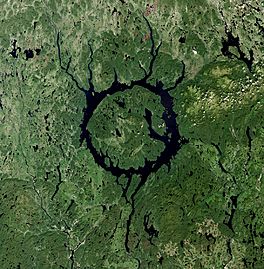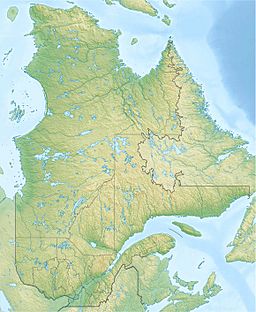Manicouagan Reservoir facts for kids
Quick facts for kids Manicouagan Reservoir |
|
|---|---|

View from orbit
|
|
| Location | Rivière-aux-Outardes, Manicouagan RCM Rivière-Mouchalagane, Caniapiscau RCM, Quebec |
| Coordinates | 51°23′N 68°42′W / 51.383°N 68.700°W |
| Lake type | annular lake, reservoir |
| Primary outflows | Manicouagan River |
| Catchment area | 29,241 km2 (11,290 sq mi) |
| Basin countries | Canada |
| Surface area | 1,942 km2 (750 sq mi) |
| Average depth | 85 m (279 ft) |
| Max. depth | 350 m (1,150 ft) |
| Water volume | 137.9 km3 (111,800,000 acre⋅ft) |
| Residence time | 8 years |
| Shore length1 | 1,322 km (821 mi) |
| Surface elevation | 342 to 359 m (1,122 to 1,178 ft) (Dates: 1980 to 2005) |
| Islands | René-Levasseur Island |
| 1 Shore length is not a well-defined measure. | |
The Manicouagan Reservoir, also known as Lake Manicouagan, is a huge ring-shaped lake in the middle of Quebec, Canada. It covers a massive area of about 1,942 square kilometers (750 square miles). In the very center of this lake is a large island called René-Levasseur Island. The tallest spot on this island is Mount Babel.
This amazing lake was formed about 214 million years ago. It happened when a giant space rock, called a meteorite, crashed into Earth. This meteorite was about 5 kilometers (3 miles) wide! The lake and its central island are so big that you can clearly see them from space. Because of its unique shape, people sometimes call it the "eye of Quebec". The lake holds a huge amount of water, about 137.9 cubic kilometers (33 cubic miles).
Contents
Exploring the Manicouagan Reservoir's Geography
The Manicouagan Reservoir is located in the Manicouagan Regional County Municipality in the Côte-Nord region of Quebec, Canada. It's about 300 kilometers (186 miles) north of the city of Baie-Comeau. A road called Quebec Route 389 runs along the eastern side of the lake.
The lake itself sits inside a huge, ancient impact crater. This crater is about 100 kilometers (62 miles) across. The most noticeable part is the lake's inner ring, which is about 70 kilometers (43 miles) wide. This ring surrounds the central island plateau, René-Levasseur Island.
Mount Babel: The Island's Highest Point
Mount Babel is the tallest peak on René-Levasseur Island. It stands about 952 meters (3,123 feet) above sea level. This means it's about 590 meters (1,936 feet) higher than the water level of the reservoir. The central part of the island is protected as the Louis-Babel Ecological Reserve.
The Giant Meteorite Impact Crater
| Impact crater/structure | |
|---|---|
| Confidence | Confirmed |
| Diameter |
|
| Impactor diameter | 5 km (3.1 mi) |
| Age | 214 ± 1 Ma |
The Manicouagan Reservoir is actually located within the remains of a very old and eroded impact crater. Scientists call this type of feature an astrobleme. This huge crater was formed when an asteroid about 5 kilometers (3 miles) in diameter crashed into Earth.
The original crater was about 100 kilometers (62 miles) wide. Over millions of years, erosion and layers of sediment have made it smaller. Today, the visible part of the crater is about 72 kilometers (45 miles) across. It is the sixth-largest confirmed impact crater on Earth, based on its rim-to-rim size. Mount Babel is thought to be the central peak of the crater. It formed when the ground pushed up after the impact.
When Did the Impact Happen?
This crater is one of the oldest known impact craters on our planet. Research shows that the rocks melted by the impact are about 214 million years old. This event happened about 12 million years before the end of the Triassic period. This means the Manicouagan impact was not the cause of the Triassic–Jurassic extinction event, which was a major extinction event that happened later.
Could There Have Been Multiple Impacts?
Some scientists have suggested that the Manicouagan crater might be part of a larger event. They think that a single asteroid or comet might have broken into pieces. These pieces then hit Earth in different places at the same time. This idea is similar to what happened when Comet Shoemaker–Levy 9 broke apart and hit Jupiter in 1994.
Scientists have found five craters that seem to form a chain. Besides Manicouagan, these include the Rochechouart crater in France, the Saint Martin crater in Manitoba, the Obolon' crater in Ukraine, and the Red Wing crater in North Dakota. This theory suggests a truly massive space event!
Hydroelectric Power Project
The Manicouagan Reservoir we see today was created in the 1960s. This happened when engineers built the huge Daniel-Johnson Dam. This dam flooded two smaller lakes, Lake Mushalagan and the original Lake Manicouagan.
This project was part of a massive series of hydroelectric power projects. These projects were built by Hydro-Québec, which is Quebec's main electricity company. The whole system of dams is often called the Manic-Outardes Project. This is because it uses water from both the Manicouagan and the Outardes rivers.
How the Reservoir Helps Make Electricity
The Manicouagan Reservoir acts like a giant storage tank for the Manicouagan River. It feeds water to several power stations located downstream. These include the Jean-Lesage generating station (Manic-2), the René-Lévesque generating station (Manic-3), and the powerhouses at the Daniel-Johnson Dam (Manic-5).
During the coldest parts of winter, the lake's water level usually drops. This is because the turbines at the power stations run constantly. They produce a lot of electricity to meet the huge demand for heating in Quebec. The lake's level can also be low in summer. This happens when Hydro-Québec sells electricity to other places, like the New England power grid in the United States, during hot weather.
See also
 In Spanish: Lago Manicouagan para niños
In Spanish: Lago Manicouagan para niños





